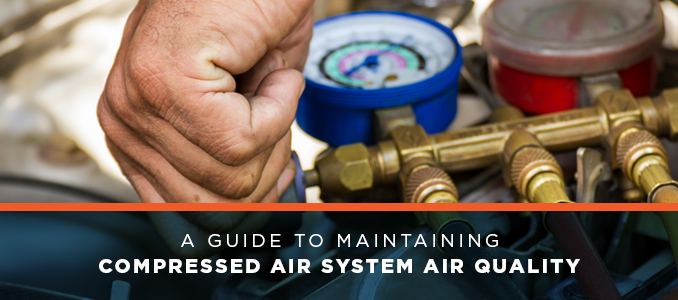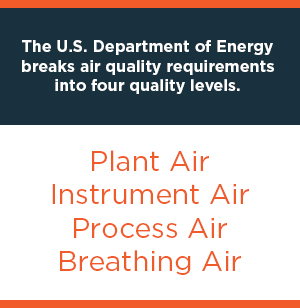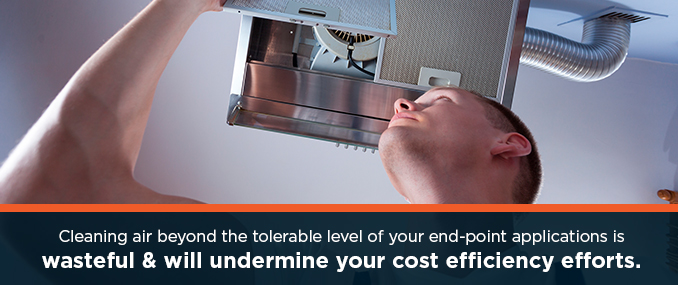
Compressed air systems are unrivaled when it comes to providing the kind of power and reliability that’s essential for industrial and commercial operations. No wonder so many industries and plants turn to compressed air systems in order to keep their lines moving and their employees working at top efficiency. Furthermore, there is a wide range of applications that can only be performed by compressed air, especially in the food, pharmaceutical and healthcare industries.
However, a compressed air system is only as good as the quality of the air within that system. Moisture, lubricants and particulates can all reduce the efficiency and efficacy of your compressed air system. Depending on the application, contaminants can even make the compressed air system unusable, as dirty air can interfere with food production or make the compressed air unbreathable when used for respiration.
In fact, according to the Compressed Air and Gas Institute, inefficient and poorly maintained compressed air systems are responsible for an estimated $3.2 billion in unnecessary utility payments.
Contact Us Learn More Find a Dealer Near You
While there are many contributing factors when it comes to wasted money within compressed air systems, air quality is a significant issue.
Since all of us at Quincy Compressor are committed to making compressed air systems work at the highest level possible, we care about the quality of your air. That’s why we’ve put together this guide on compressed air system quality. We will start by identifying common causes of poor air quality within compressed air systems. Next, we will discuss how these issues might negatively influence the application of compressed air within your plant. Finally, we will present you with some tips and suggestions for improving your compressed air system air quality in ways that are appropriate for various operations.
In the end, we know that compressed air is the best way to keep American industry working. That’s why we’re here to help you operate your compressed air system at peak performance.
Common Air Quality Issues Within Compressed Air Systems
Let’s begin with the most common air quality issues that influence compressed air system performance. While many industries will work right through air quality issues without ever noticing their adverse effects, if you search out these concerns, you will find that you can save big on energy costs while improving end-use performance.
With that in mind, here are the most common air quality issues found within compressed air systems.
Particulates:
The word “particulate” refers to any small pieces of solid material that can be found suspended in the air, usually in the form of dust. However, while dust may seem like a minor issue, when it comes to compressed air systems, the presence of particulates can have a huge negative impact on performance.
Additionally, particulates can often go unnoticed, due to their small size.
Consider these statistics from Air Compressor Works. Human hair is, on average, 50 to 70 microns thick. The largest particle the human eye can see is around 40 to 50 microns thick. Yet, particulates considered to be “big” are a mere three to five microns thick. Even particulates the size of .01 microns can have an adverse effect on your compressed air system.
Depending on the industry in which the compressed air system is installed, the risk of particulate contamination is even greater. If a compressed air system is installed in a wood shop, for example, the amount of sawdust alone can have a huge effect on compressed air efficiency. While much of the larger, visible saw dust can be easily dealt with, it’s the microscopic dust that can really pose a problem.
Moisture:
Moisture, in the form of humidity, is another big concern for compressed air quality. Because air compressors produce hot air, that air can hold a relatively high level of moisture. However, cooler air cannot hold the same level of moisture, and so, as the compressed air moves away from the compressor and thus cools, moisture can begin to build up. Unfortunately, this condensation can wreak havoc on compressed air efficiency while also causing increased wear on the system, shortening its life.
Lubricants:
Unfortunately, just as keeping your compressed air system adequately lubricated is essential for system maintenance, over-lubricating your system can have the opposite effect. While lubrication ensures that both the compressor and end-use tools are working properly while reducing wear, too much lubrication, especially if the lubricant is low-quality, will start to gum up the system, reducing efficiency while adding contaminants to the compressed air.
Of course, lubricants are only a factor in compressed air systems that require lubrication. Some industries, such as food or pharmaceutical production, require lubricant-free compression. However, even lubricant-free compression systems are still at risk of contamination from particulates and condensation.
The Negative Effects of Poor Air Quality
While it may seem to be a minor issue, poor air quality is responsible for a number of significant compressed air system issues, all of which can result in poor performance, lowered energy efficiency and equipment malfunction.
To start, moisture within compressed air systems can significantly damage the piping system. Moisture inevitably leads to rust, which can cause your entire compressed air system to eventually fail. However, even some moisture present within the air can also sap efficiency.
Particulates can also start to increase the wear on your compressed air system — especially end-use tools. Furthermore, too much particulate can lead to an increased need for lubricants, which could then result in higher levels of lubricant contamination.
Finally, while lubricant contamination can decrease the efficiency of end-use tools and the compressor motor, it is an especially serious concern for any food industry or plants that need to create pure chemicals.
Regardless of the contaminant, poor air quality can put added pressure on the compressor motor. Compressors need to vent heat, and contaminant-damaged lines can hinder the ability of the compressor to vent. This excess heat can eventually lead to motor failure.
It’s also worth noting that air quality issues affect all compressors, regardless of the expense of the compressor. Contaminants and air quality issues are found in the ambient environment and are not caused by older or less expensive compressor systems. So don’t assume that the newness or price of your compressor system means that you don’t need to worry about the air quality within your system.
Ultimately, the cost of poor air quality is very real, as low-quality air can cause energy costs to mount while also contributing to equipment downtime, which decreases worker efficiency while causing manufacturing lines to halt. But beyond increased maintenance costs, poor air quality is also a leading cause of decreased compressor life, leading to costly and otherwise unnecessary replacements.
Industry-Specific Air Quality
It’s also important to consider the compressed air application that is specific to your industry. While some compressed air applications have lower standards, others require incredibly high-quality air in order to perform the required operation.
The U.S. Department of Energy breaks air quality requirements into four quality levels. They are as follows:
- Plant Air: These compressed air applications predominately represent tools and other equipment used in industrial manufacturing.
- Instrument Air: In these applications, compressed air is used for more exacting operations, such as in laboratories, powder coating and industrial paint application.
- Process Air: Compressed air applications in this category need to be very clean, as contaminants could ruin the products being produced, such as food, electronics or pharmaceuticals.
- Breathing Air: These applications require compressed and breathable air, such as in hospitals or in industries that require respiration.
While all industries, even those that fall into the “Plant Air” category, require a certain level of air quality in order to ensure efficiency and compressor functionality, there are increasingly higher standards for each level of compressed air applications. Depending on your air quality category, you may need to be prepared for a more rigorous approach to air quality.
Addressing Air Quality Concerns
Now that we’ve explored the causes and consequences of poor air quality within compressed air systems, what can you do to help improve the air quality of your system? Here are a couple general approaches to air quality that you should consider before investing in dedicated equipment that will filter, dry and otherwise improve the air in your compressed air system.
Determine your air quality requirements:
While we have already discussed the varying air quality requirements of several industries, there are even more diverse requirements contingent upon end-point applications and factory recommendations for individual compression systems.
Start by determining what your specific tools and compressor system requires. This will be determined by the factory specifications, in addition to purity requirements for your compressed air applications.
Improving air quality only up to the level required is important. Cleaning air beyond the tolerable level of your end-point applications is wasteful and will undermine your cost efficiency efforts. Filtration and drying equipment can be expensive, so you want to make sure you’re only investing in a level of filtration that will allow you to recoup the costs in the long run.
Additionally, filtration and cooling will decrease air pressure throughout the system. So you need to determine just how much filtration you need in order to improve efficiency without filtering so much that you end up sacrificing more efficiency than you’re saving through cleaning the air.
In regards to end-point applications, you may also find that you have a wide variety of air quality requirements within a single compression system. If your compression requirements vary across a single system, there are ways to cater your filtration and drying approaches to the various components.
Finally, while poor air quality is responsible for compressor downtime, keep in mind that more equipment means you’ll have more opportunities for equipment malfunction. So: don’t invest in equipment you do not need.
All that being said, just as you don’t want to over-clean your air, investing in filtration is integral for maintaining a high-quality compression system. While over-cleaning and over-drying may be wasteful, under-cleaning is equally wasteful as far as long-term investment is concerned. The key is finding the level of filtration that is suited for your specific air quality needs.
Group equipment with similar requirements together:
If only a portion of your equipment requires a high level of air quality, consider placing these end-point functions in the same area of your plant, if it’s practical. This will allow you to apply air cleaning measures to only the portion of your system that requires it, without applying that level of air quality to the rest of the plant. Furthermore, if the compressed air system is large enough, isolating the portions that require additional filtration will allow you to locate necessary equipment in the same area, limiting the opportunity for diminished air quality after the point of filtration.
However, keep in mind that this approach may affect your larger plant processes, sometimes adversely. That’s why you want to weigh the benefits with the costs. For example, if the differential in air quality requirements across your system is minor, the savings obtained from isolating air cleaning measures are unlikely to offset the cost of altering plant processes. Furthermore, if your entire system is small, the cost of cleaning the air within the entire system may not be that much higher than cleaning a smaller portion.
That being said, considering that filtration and drying processes can sap pressure while increasing energy costs, grouping your filtration is a great way to utilize these air quality measures where necessary, while avoiding some of the negative issues associated with increased air cleaning. If you can raise air quality while using smaller improvement machinery by isolating those areas where the additional measures are required, you will maximize energy savings while extending the life of your system and simultaneously minimizing investment and operational costs.
Specific Methods for Improving Air Quality
Once you have determined your specific needs for air quality improvement, you will need to invest in additional machinery that will bring your air quality to the required level. Here is a breakdown of the most common devices employed to improve air quality within compressed air systems.
Because one of the major causes of condensation within compressed air systems is the cooling of hot, compressed air when exposed to the surrounding ambient temperature, aftercoolers cool the air before it heads toward the end-point. Once cooled, the water is removed, leaving the compressed air relatively close to ambient temperature. The cooler compressed air will, therefore, not cause condensation to form in the piping leading it to the end point.
There are two varieties of aftercoolers. The most basic type is air-cooled. The compressed air is passed through a device that essentially looks like a radiator in a car. While passing through the cooler, air is blown across the tubes, thus cooling the compressed air inside.
There are also water-cooled aftercoolers that use water to cool the compressed air. While these are more efficient, they require a water source that may not be available in every plant. Furthermore, the water that’s used is subsequently heated, which must then be disposed of — another process that further complicates an already complicated system.
Many compressed air systems come with aftercoolers already installed.
Dryers offer another approach to reducing condensation within compressed air systems. They are more common in systems that require a more robust approach to removing moisture.
Rather than simply cooling the compressed air to the level of the ambient temperature, dryers lower the dew point of the compressed air so that condensation isn’t possible.
First, the compressed air is refrigerated. The compressed air is then run through a filter that removes water from the cooled air. The result is a dry air that can change temperature without condensing. Typical dryers lower the dew point to around 38 degrees Fahrenheit.
However, you want to be sure that you need the kind of drying provided by these devices, and you also want to make sure they’re accurately sized for your compressed air system. They are energy-intensive, and so, if you’re over-drying your compressed air, you will be losing money, rather than saving it. So: make sure the level of drying you’re employing matches what your air compression system can tolerate. There is nothing to be gained from air that is dryer than what your system requires.
There are two types of filtration that can be used to improve air quality in your compressed air system. The first is designed to remove particulates. These filters can be tailored to the level of end-point tolerance specific to your system. It’s not uncommon for filters to remove particulates a small as .01 microns thick. However, keep in mind that the more robust the filtration is, the more the filter will influence air pressure levels. Make sure you use just as much filtration as your particular compressed air system needs.
There are also oil filters designed to remove lubricant contaminants from compressed air systems. These are often included in a lubricated system, but if you’re finding that you need more filtration, especially if you have an operation with a low tolerance for lubricant — such as food production — you should also consider additional oil filters.
Remember: filtration only works if filters are regularly inspected and cleaned as needed. This is not a set-it-and-forget-it system, so make sure you’re staying on top of the regular required maintenance. It’s also important to remember that filtration is the key to clean air. A pristine, high-end compression system without filtration will not provide clean, compressed air. Simultaneously, an old, oil-leaking and inefficient compression motor can still produce clean air if that air is filtered before it reaches the end-point. So don’t rely on a new system to be clean just because it’s new.
Consult With Quincy Compressor to Improve Air Quality
In the end, one of the best ways to improve air quality is to bring in an expert who can grade your air quality and identify the best approach for increasing the quality as needed.
For almost a century, Quincy Compressor has been leading the industry in compressed air systems manufacturing and maintenance. We supply compressed air systems to a wide range of industries, including food and beverage production, woodworking, plastics fabrication, plumbing supply, painting, pharmaceuticals, automobile, agriculture and energy exploration.
Our experts and professional consultants are eager to help you identify the best approach to improving air quality within your system, thus improving energy efficiency while also extending the life of your compressor.
Furthermore, if you’re ready to install the equipment needed to improve air quality, we supply a wide range of dryers, filters and condensate purifiers. We have the experience to ensure that these systems are perfectly sized and tailored to your specific needs, helping you get the most value out of your compressed air system.
So, if you’re ready to reap the benefits of a highly efficient and top-performing compressed air system created through clean, high-quality air, then look no further than Quincy Compressor. Our sales representatives and service staff are waiting to hear from you, so contact us today.
Alternatively, make use of our handy Sales and Service Locator to find an authorized Quincy Compressor sales and service representative in your area. Either way, know you can rely on Quincy Compressor to provide you with everything you need to keep your business moving and your compressed air system operating at peak efficiency.










